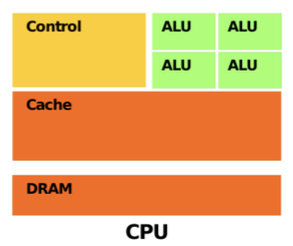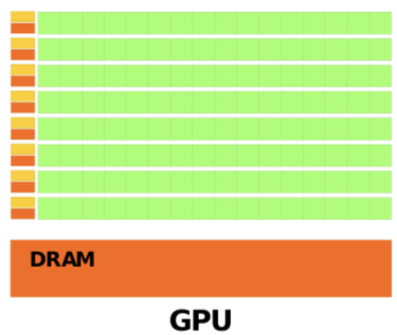Parallelism and Vectorization
Vectorization
Consider a single layer in MLP:
Naive implementation:
- Loop over and , build products
- Then compute sigmoid over
for j in range(m):
for i in range(n):
y_j += w_ij * x_i
z_j = sigmoid(y_j)
“for-loop” over all values is slow
- Lots of “jmp“s
- Caching unclear
Modern CPUs have support for SIMD operations
vector operations are faster than looping over individual elements
In the example above, actually we are just computing
Using vectorized hardware instructions is much faster 💪
Parallelism
Is there even more to get?
Computation of independent results in parallel! 💪
Parallelism in CPUs

Structure
- Several Compute Cores (ALUs)
- Complex control logic
- Large Caches (L1 / L2, …)
- Optimized for serial operations like regular program flow
- shallow pipelines
- Increasingly more cores
- Parallelizing code will give speedup
- Libraries exist that do that for us (BLAS…)
CPUs were build for (mostly) sequential code
Computations in deep learning are extremely deterministic
- Known sequence of operation
- No branches no out of order
- All parallel operations essentially do the same
- After computing something the same input is rarely used again
Different kind of hardware might be better suited
Parallelism in GPUs

- Many Compute Cores (ALUs)
- Built for parallel operations
- Deep pipelines (hundreds of stages) High throughput
- Newer GPUs:
- More like CPUs
- Multiway pipelines
Frameworks for Deep Learning
- Abstraction for access and usage of (GPU) resources
- Reference implementation for typical components
- Layers
- Activation functions
- Loss Functions
- Optimization algorithms
- Common Models
- …
- Automatic differentiation
Variants of Deep Learning Frameworks
Static Computational Graph
- Computation graph is created ahead of time
- Interaction with the computational graph by “executing” the graph on data
- Errors in the graph will cause problems during creation
- Hard to debug
- Flow Control more difficult (especially writing RNNs)
Dynamic Graph builders
- Uses general purpose automatic differentiation operator overloading
- Models are written like regular programs, including
- Branching
- Loops
- Recursion
- Procedure calls
- Errors in Graph will cause problems during “runtime”
Automatic Differentiation
Automatic construction of procedure to compute derivative of computed value
- Reverse Mode
- Converting program into a sequence of primitive operations with known derivatives
- Each element of a computing graph has a rule how to build the gradient
- During forward pass, intermediate results are stored
- Backward pass can compute gradients based on rule and stored results
- => backprop can be done completely mechanical
- Forward Mode
- Computed during forward pass in parallel with evaluation